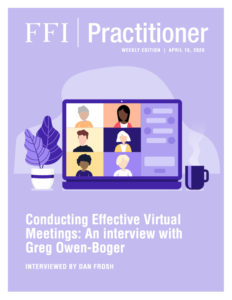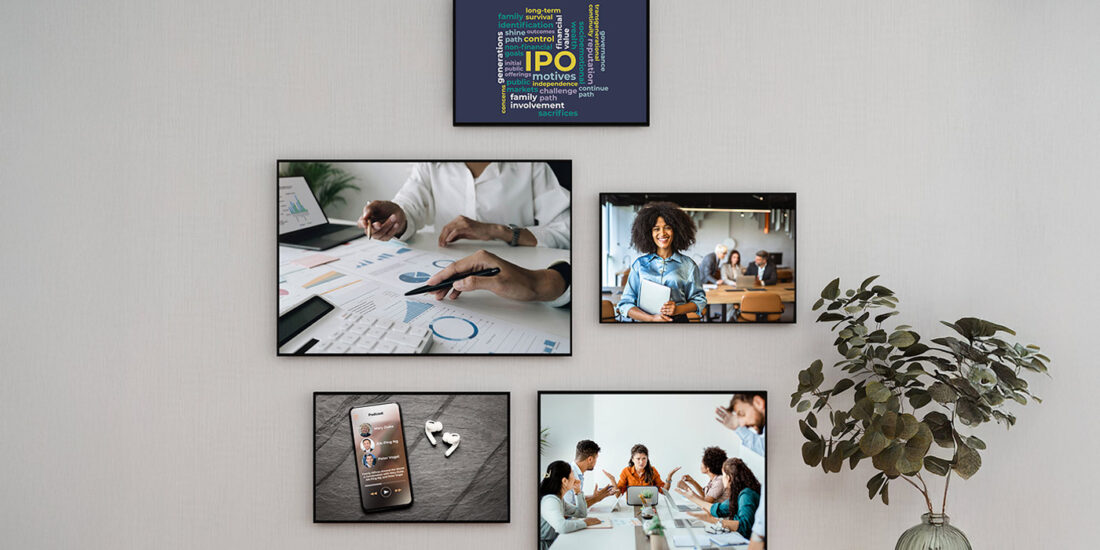
View this edition in our enhanced digital edition format with supporting visual insight and information.
Recently many family enterprise advisors have adapted their practices to work more effectively with clients by using online technologies. This week’s edition discusses some of the challenges with “remote” consulting and how advisors can make the best use of the virtual environment. Please join FFI Practitioner Managing Editor Dan Frosh as he interviews Greg Owen-Boger of Turpin Communication on how to conduct effective virtual meetings with family enterprise clients as well as professional colleagues.
Dan Frosh: Hello and welcome to this week’s edition of FFI Practitioner, a publication brought to you by the Family Firm Institute. I’m Dan Frosh, the Managing Editor of FFI Practitioner, and for this week’s edition, I have the privilege of speaking with Greg Owen-Boger about a topic of perennial importance within the field of family enterprise advising, which is how to run an effective virtual meeting.
Greg Owen-Boger: Hey Dan, thanks for having me. It’s nice to be working with you again.
DF: In your experience, what are some best practices for facilitators to utilize when setting up their remote offices to host a virtual meeting?
GO: Now that we are working so much virtually, we have to think about what that means in our physical space, because now people are being invited into our homes in this very, very intimate way. So, think about the background that you’re in (assuming that you’re using video) and make sure that you have decluttered the area. Try to light your face the best you can and think about how your face is framed within the camera. I like to think of the rule of thirds. That’s where you put up a tic-tac-toe drawing over the lens, and then adjust the camera so that your eyes are in the top third.
DF: For most family business advisors that I speak with, robust reference materials and documents play a major part of guiding their in-person meetings with family clients. What if any modifications should advisors make to these materials to be more conducive to a virtual meeting environment?
GO: I think that just using the materials “as is” is probably not a good idea. You have to think, “How am I going to deliver this material to folks in a way that keeps them focused where I want them to be focused?” So, of course we’re sharing screens all the time and you can show PowerPoint slides, documents, spreadsheets, brochures — if it’s on your computer, you can share it. If you put [your materials] into PowerPoint, you have a little more control over where people focus because you can animate items on your slide. So, I think that animation is really an important piece of this. I like to think of it as only giving people one bite at a time, maybe one bullet point at a time, or one image at a time.
Also, when you are delivering the material, you want to use directional or descriptive language. So, let’s say you’ve got a spreadsheet and there’s a slide with a bar graph and a pie chart, saying something like, “I’d like to focus on the orange piece of the pie chart that’s on the right-hand side of the screen.” It’s really being very descriptive —and I like to think of it as going on a tour.
DF: How should advisors alter the structure and organization of their meetings from an in-person setting to a virtual one? Given the increased distractions for meeting attendees at home, and likely shorter attention spans, how would you advise practitioners to structure these virtual meetings to keep participants engaged?
GO: That’s a great point, you just cannot recreate a full-day meeting in the virtual space. The best practice here is to cut up the meetings content into smaller chunks. And we really believe that two hours is about the maximum that you can ask people to go without a breather. Now, we have done it in the past, where maybe it’s a three-hour block, but you have to include maybe a 15-minute break in there. This is a “reset the brain” break because it requires to be fully engaged.
Let’s make the assumption that everyone is fully engaged. But the reality is that the longer the meeting, the less engaged they’re likely to be. So that is the big thing, and I also think, if it’s possible, you can give people assignments in between two-hour chunks. So, you’re still keeping their brains active, just not in the virtual space.
DF: Most family business advisors are already relatively proficient in facilitating in-person meetings. How can these skills translate to a virtual meeting?
GO: It’s so true that it’s one thing to be an excellent facilitator in live, face-to-face meetings, but it is so much more challenging when you’re in the virtual space because you only have control over what’s happening in your personal space—you can’t control what everyone else is doing—so, you have to be so much more on your toes.
The first recommendation I would make is to set your expectations. If you expect people to be on video, let them know that. If you want them to make sure that their cell phones are off and their email is shut down, set those expectations because people can’t meet expectations unless they know what they are.
So, that’s the first piece. The other piece is making sure that you are setting the proper context for the work that is to be done. A lot of times, we go into a meeting, it’s a little “wiggly” about what we are trying to accomplish. So, don’t be that sort of facilitator — be crystal clear upfront.
A third thing that you can do to keep people engaged is to use their names. There’s something about when a facilitator uses people’s names, it sends the message to everybody else that, “Oh boy, she might be calling on me next. I better pay attention.”
And something else that you should think about is the importance of silence. Because, if you’re using video, you don’t always know if someone is about to speak, so you have to clear the space for them to be able to have time to formulate what they want to say and then, find the unmute button so that they can actually say it!
I think, also, you want to be aware of your own body language and what is the message that you are sending through your body – are you closed off? Are you looking distracted? Because the thing about video, and I really do recommend video right now because it’s the only human connection some of us have, is when I’m looking into the camera lens — and that is what we recommend — to look into the lens. The sense is that you are making eye contact with everyone else, but you’re not getting it in return. in other words that icon visual. So, you really have to think about, “how am I being perceived?” much more than you normally do when you’re in a live, face-to-face situation.
DF: I’d like to build upon that notion you raised about the ability to read body language and nonverbal cues in the virtual setting What tips do you have for advisors to pick up on these non-verbal cues and make the necessary connection with family members to gain their trust when addressing sensitive issues?
GO: I’ve been thinking about this a lot and came up with an idea that I want to float out there. I know that many of the advisors probably work by themselves in these meetings, but there may be opportunities to work with a partner in these meetings.
So, let me paint the picture for you. Let’s say that I am the lead facilitator. So, I’m spending my energy on my level of engagement with [the attendees], thinking about how I’m being perceived, running through the contents, and facilitating the discussion.
But, let’s say you’re my partner in this meeting. You could be watching body language for me on the video, so that would be your primary responsibility, and then when you are starting to pick up on negative body language or something that’s interesting, you and I can have a secondary channel to communicate, – and I do recommend that it be a third party. Don’t use the chat feature for this sort of communication that’s in the platform because it’s too easy to accidentally send a message to the wrong group of people!
DF: Do you find it is more challenging to manage time and stick to an agenda on a virtual meeting than in-person?
GO: Yeah, I wish I could put into words why time management is more difficult in the virtual space, but almost everybody agrees that it’s just really difficult. So, obviously, keeping your eye on the clock is something that you can do. But, I think also on the planning side, recognize that you’re not going to be able to accomplish as much in a virtual space as you could, in a face-to-face space, so just recognize that that’s the reality that you’re dealing with at this point.
DF: Greg, it has been an absolute pleasure speaking with you today and thank you on behalf of FFI for your time and expertise.
GO: It’s been an absolute pleasure. Thanks so much.
About the Contributors

Greg Owen-Boger is vice president of Turpin Communication and has served as a facilitator and coach since 1995. He is co-author of two books, The Orderly Conversation: Business Presentations Redefined and Effective SMEs: A Trainer’s Guide for Helping Subject Matter Experts Facilitate Learning, both written with Dale Ludwig, Turpin’s founder. Greg and his team have been working with FFI GEN faculty to develop in-person and virtual presentation skills. Greg can be reached at greg@turpincommunication.com.

Dan Frosh, CFBA, CFWA, is an attorney and advisor at Cambridge Advisors to Family Enterprise. He is a current member of the FFI board of directors and serves as the Managing Editor for FFI Practitioner. Dan graduated from Suffolk Law School, where he focused on estate planning and closely-held enterprises. He lives in Los Angeles and can be reached at dfrosh@cfeg.com.

View this edition in our enhanced digital edition format with supporting visual insight and information.





